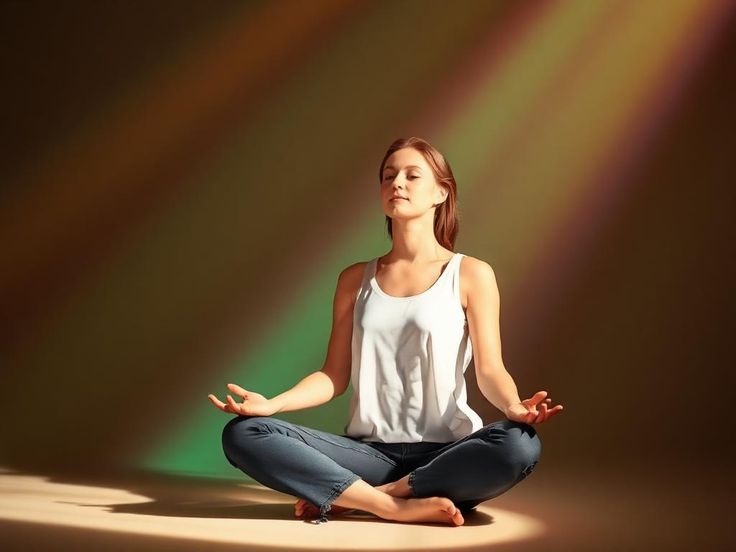Unlocking Inner Calm: A Beginner's Guide to Meditation Techniques
In our fast-paced world, it often feels like we’re constantly juggling tasks, notifications, and demands. Our days zoom by in a blur, leaving us feeling stressed and disconnected. But what if there was a way to slow down, find your center, and reclaim some calm, no matter how busy life gets?
The good news is, achieving this balance isn’t just a dream – it’s entirely possible and within your reach. It’s about finding simple, powerful tools that help you manage the daily rush and nurture your inner peace.
What is Meditation and Why Does It Matter for Your Wellbeing?
At its heart, meditation is simply a practice of training your attention and awareness to be present in the moment. It’s not about emptying your mind or stopping your thoughts (that’s a common myth!). Instead, it’s about learning to observe your thoughts and feelings without getting caught up in them, like watching clouds drift across the sky or noticing the cars passing by on the road.
Why is this important? In our busy lives, our minds often jump from one thing to another, creating mental chatter and stress. Meditation helps you gently bring your focus back to the present moment, which can calm your nervous system and reduce anxiety. It’s like giving your brain a much-needed break from constant activity.
This practice is deeply linked to your wellbeing. Regular meditation can improve your mental clarity, boost your emotional resilience, and even enhance your physical health by lowering stress hormones. It helps you respond to life’s challenges more calmly, sleep better, and generally feel more at peace. Think of it as an exercise for your mind – strengthening your ability to handle whatever comes your way.

Your First Steps: Simple Meditation Techniques for Beginners
Do you feel a natural pull to explore the world of meditation but are unsure where to start from? Don’t worry! There’s no “right” way to meditate, and finding what works for you is part of the journey. Here are five easy, beginner-friendly meditation techniques you can try today:
1. Alternate Mindful Breathing
This technique helps calm your mind and balance your energy by focusing on the gentle flow of your breath. It’s simple and can be done anywhere.
🌟 How to do it:
Find a comfortable seated position. Keep you back straight. Take a deep breath in and slowly exhale out – repeat five to six times. Gently close one nostril with your thumb and inhale slowly through the other nostril. Then, close the open nostril with your ring finger, release your thumb, and exhale through the first nostril. Now, inhale through that same nostril, close it, and exhale through the other. Keep alternating. The key is to make your breath smooth and even – so much so that no sound can be heard while you’re doing so.
🌟 Why it’s good for you:
This breathing exercise is known to soothe your nervous system, reduce stress, and improve focus. It’s perfect for when you need a quick mental reset during a busy day. You can do this at any hour of the day for a minimum of 3 minutes. Remember to do a few rounds of normal breathing after you finish the technique.
2. Guided Meditation
If you prefer to be led as you find it difficult to meditate on your own, then guided meditation is a perfect starting point as someone else’s voice will lead you through the process, making it easier for you to follow along.
🌟 How to do it:
Search for free guided meditations on YouTube or popular apps like Calm or Headspace. Find a quiet spot, sit straight or you can even lie down, put on your headphones, and simply listen to the instructor’s voice. They will guide your attention, often to your breath or different parts of your body. Just follow the lead to experience the joy of meditation.
🌟 Why it’s good for you:
It takes away the guesswork and helps keep your mind from wandering. It’s great for beginners who might feel unsure about how to meditate on their own, providing structure, guidance and support along the way.
3. Mantra Meditation
Do you have a busy mind that struggles to stay focused? If yes, then Mantra meditation might just be the perfect option for you. A mantra is a word, sound, or phrase you repeat silently or aloud to keep your attention steady. When you constantly meditate on that phrase, it creates a peaceful sensation within you which is known for calming down your nerves and entire immune system.
🌟 How to do it:
Choose a word that resonates with you, like “calm,” “peace,” “love,” or a simple sound like “Om.” Sit comfortably with your back straight and begin to gently repeat your chosen mantra. When your mind drifts (which it will!), just notice it and kindly bring your attention back to the mantra. You can do this for as long as you feel like!
🌟 Why it’s good for you:
Repeating a mantra can help quiet mental chatter and create a steady rhythm for your mind. It’s a comforting anchor that helps you settle into a meditative state.
4. Walking Meditation
Meditation doesn’t always mean sitting still. Did you know that there’s something called as a walking meditation too? Walking meditation basically allows you to bring mindfulness into your everyday movement and is perfect for those who find stillness challenging.
🌟 How to do it:
Find a quiet space where you can walk, even if its just a few steps back and forth, or where you can take a short walk somewhere out in nature. Now, instead of focusing on your destination, pay attention to the act of walking itself. Notice the sensation of your feet touching the ground, the movement of your legs, and the feeling of your body in motion.
Be aware of your surroundings, but don’t get lost in thought. If you find this difficult, try counting your steps – that will keep your focus in sync with your steps. You can start with as small as one whole round or set a timer for 3 minutes for the initial few days. The time can then be extended for as long as you like.
🌟 Why it’s good for you:
It helps you stay grounded and present while being active. This is an excellent way to integrate mindfulness into your day by turning a simple walk into a powerful meditation practice.
5. 5 Senses Meditation
This technique is a simple and effective way to ground yourself in the present moment by engaging all your senses. It’s a great exercise for quickly shifting your focus from stress to the immediate environment. I highly recommend this to people who are dealing with anxiety, worry, depression and alike states.
🌟 How to do it:
Find a comfortable spot. Take a few deep breaths. Then, slowly and mindfully, notice:
- 5 things you can see: Look around and identify five objects. It could be anything.
- 4 things you can feel: Notice sensations like your clothes on your skin, the chair beneath you, or the air temperature.
- 3 things you can hear: Listen for three distinct sounds, near or far in your surrounding.
- 2 things you can smell: Take a gentle sniff and identify two scents around you.
- 1 thing you can taste: Notice any taste in your mouth, even a lingering one.
🌟 Why it’s good for you:
This method quickly pulls your attention away from worries and brings you into the “here and now.” It’s a powerful tool for instantly reducing anxiety and enhancing your awareness of the present moment.

The Power of Consistency: Making Meditation Part of Your Life
Starting a meditation practice is like planting a tiny seed – it needs regular care and patience to grow. You may not see results right away, but even just a few minutes of daily practice can lead to noticeable shifts in a few weeks or months. It’s a lot like building a muscle – the more you show up, the stronger your sense of calm becomes.
The beauty of meditation is how deeply it can support your life. From better sleep to handling everyday stress with more ease, its benefits are real and lasting. Don’t worry about doing it perfectly, just aim to stay consistent. Try out these five simple meditation techniques and see which one feels right for you. It might be mindful breathing before work, a guided session at bedtime, or a short walking meditation on your lunch break.
Remember, your well-being is a journey, not a finish line. By adding these gentle practices into your day, you’re not just finding calm, you’re choosing a more balanced, fulfilling way of life. So, are you ready to begin this beautiful journey?


